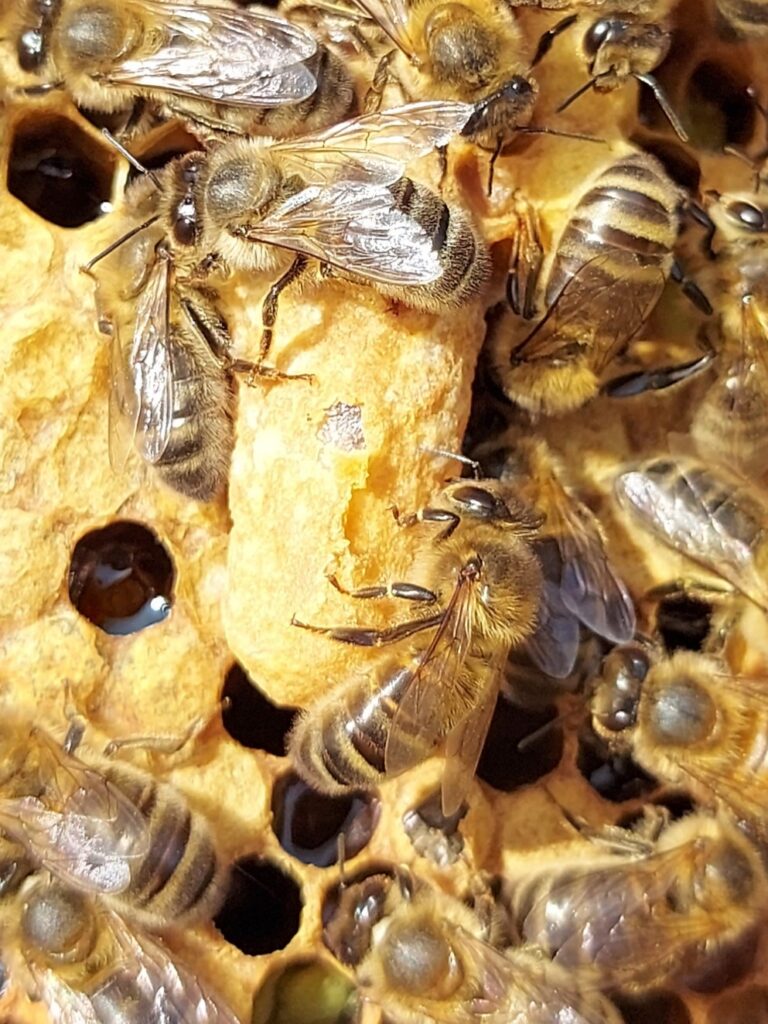The Crazy Busy Season
Catching Up
Unfortunately we lost three of our hives, sadly including our original queen (Victoria) in February this year. It’s very difficult to be certain what causes a colony to dwindle to an unsustainable number of bees (they need lots of bees to generate heat to keep warm) but we are fairly certain two were down to queen failure – the queens ran out of steam for laying fertilised worker bee eggs, therefore there are no new bees to keep numbers up. One, we think, was the extreme cold snap we had in February. Certainly our loss of three out of five hives is higher than the average 20%


Splitting Up
Although the loss of those 3 hives was horrible , two thriving hives came through winter well, so now the focus is to increase bee and colony numbers again. This is something that bee colonies want to do naturally so we just need to help them along a bit. We have taken “splits” from our two hives. We manipulated the placing of honey supers between two brood boxes (a pre-emptive demaree, should anyone want to look into it in detail) in such a way that the queen is in the bottom box with all the foraging bees and lots of fresh new foundation frames. This has two effects – this replicates the conditions in the bottom box as if the bees had just swarmed and were setting up a new home and, at the same time, the nurse bees and brood, who were all put on the top floor, as it were, above two honey supers on top of the bottom brood box, are so far from the queen that they can’t smell her queen pheromones any more. The bottom box therefore don’t feel the need to swarm so you are less likely to lose them and the precious queen, and in the top box the bees think they have become queenless and they draw out queen cells to raise a new queen to replace her and carry on the colony (see image).
Ramping Up
As mentioned before, a colony’s natural inclination is to swarm. If you think of a colony as a single entity, then swarming is how bees make one become two (or more). When a swarm happens, the current queen leaves the existing hive with a good proportion (perhaps 50% – 75%) of the flying bees. They leave behind the brood, the stores and the nurse bees. The familiar site of a swarm on a branch is where they huddle while the scout bees work out where their new home will be.
It is possible to lure a swarm into a bait hive that you set out, which is what we just succeeded in doing! We adapted a brood box into just the sort of small opening, large cavity area they look for, with the added benefit of bee smells, by adding in an old frame of comb. So from two hives, we now have three queenright hives and three further small colonies which are hopefully bringing on their new queen as I type! If the egg is laid on day 1, then you would expect the new virgin queen to emerge on day 16. But she’ll need a week or two to mature and then go on her mating flights, before she can settle down and start laying her eggs for the new generations. Inspections of colonies where there are skittish virgin queens should definitely be avoided, in case this process is unduly unsettling and the queen flies off, or becomes confused when trying to return to her hive from a mating flight and doesn’t recognise home. I therefore need to curb my impatience and wait. I just need to let the bees get on with it, and I can check in another week or two how they have all got on.
